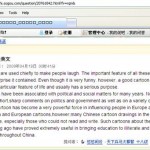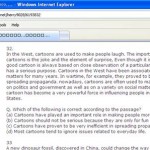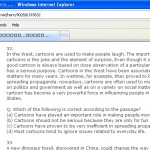Không nói hết những chuyện tủi hổ mà người cầm quyền lớn nhỏ của đất nước này gây ra để tai tiếng cho cả một dân tộc. Hôm qua BVN có nhắc, nếu dân chúng đi ra nước ngoài thì nên mang theo mỗi người… một cái mo cau. Như chuyện đạo văn này, lãnh đạo Bộ GD&ĐT ở đâu sao các chuyên trách cấp dưới làm những điều tồi tệ thế kia mà không hề biết? Và bây giờ các trang mạng đã đưa lên rồi vẫn chưa thấy quý Bộ lên tiếng nhận lỗi và xem xét kỷ luật người làm bậy để công khai cho mọi người trong nước và ngoài nước cùng biết? Thời buổi internet đâu có thể cứ muốn làm gì thì đóng cửa lại mà làm. Phép nước thế thử hỏi còn gọi là nghiêm minh được mấy phần?
Bauxite Việt Nam
Hôm qua, tôi đã có vài dòng nhận xét về đề thi tiếng Anh của Bộ Giáo dục và Đào tạo. Hôm nay, có bạn đọc chỉ ra rằng câu hỏi trong đề thi thực ra được cóp từ một nguồn ở ngoài! Chẳng lẽ Bộ GDĐT đạo văn? Rất có thể.
Trong đề thi tuyển sinh phần tiếng Anh (khối D), có một đoạn văn khoảng 450 từ so sánh đặc tính của truyện tranh Âu Mỹ và Trung Quốc. Nội dung đoạn văn ngầm chỉ trích truyện tranh Âu Mỹ tuyên truyền chính trị bằng biếm họa, còn truyện tranh Trung Quốc thì mang tính giáo dục. Điều đáng nói là đề thi có nhiều sai sót về cách cấu trúc ý tưởng, câu văn, và thậm chí cách dùng mạo từ cũng sai. Ngay cả cách bỏ dấu phẩy cũng có vấn đề. Để chắc ăn tôi đã cho một chuyên gia về báo chí của Úc xem qua đề thi, và bà này cũng có cùng nhận xét với tôi. Một bạn đọc du học sinh đang là nghiên cứu sinh Tiến sĩ tại Úc còn email riêng cho tôi và viết “Cháu đọc những nhận xét của chú về đề thi ĐH năm nay và nhận thấy những bất cập chú nêu là có cơ sở. Ngoài ra, nếu phân tích về từ vựng thì theo cháu đang còn nhiều sai sót nữa”. Thật khó tưởng tượng nổi một đề thi tuyển sinh đại học mà phạm phải những lỗi căn bản như thế!
Cách diễn tả thì rất đặc thù Trung Hoa (và có phần Việt Nam). Chính vì cách viết mang màu sắc Á châu mà một đồng nghiệp của tôi đã thắc mắc không biết đây là đề thi do chính các chuyên gia của Bộ GDĐT soạn ra, hay là họ lấy từ một nguồn khác. Độc giả du học sinh tôi vừa nhắc trên có cung cấp một trang blog với đoạn văn y chang như trong đề thi của Bộ GDĐT. Thật ra, một vài trang blog khác (chẳng hạn như trang này) cũng có đề thi tương tự, nhưng ngắn hơn. Có thể so sánh 2 bản dưới đây để thấy Bộ GDĐT đã lấy đoạn nào và gọt bỏ đoạn nào:
Hai đoạn văn giống hệt nhau (chữ tô màu vàng là khác nhau)
| Một đoạn câu hỏi tiếng Anh trên mạng | Đề thi đại học tiếng Anh 2010, mã đề 358 |
| In the West, cartoons are used to make people laugh. The important feature of all these cartoons is the joke and the element of surprise, Even though it is all very funny, however, a good cartoon is always based on close observation of a particular feature of life and usually has a serious purpose.
Cartoons in the West have been associated with political and social matters for many years. In wartime, for example, they proved to be an excellent way of spreading propaganda. Nowadays, cartoons are often used to make short, sharp comments on politics and government as well as on a variety on social matters. In this way, the modern cartoon has become a very powerful force in influencing people in Europe and the United States. |
In the West, cartoons are used chiefly to make people laugh. The important feature of all these cartoons is the joke and the element of surprise which is contained. Even though it is very funny, a good cartoon is always based on close observation of a particular feature of life and usually has a serious purpose.
Cartoons in the West have been associated with political and social matters for many years. In wartime, for example, they proved to be an excellent way of spreading propaganda. Nowadays cartoons are often used to make short, sharp comments on politics and governments as well as on a variety of social matters. In this way, the modern cartoon has become a very powerful force in influencing people in Europe and the United States. |
| Một version khác thấy trên mạng | Đoạn dưới đây không có ở mạng trích dẫn đầu nhưng lại có ở mạng khác |
| In the West,cartoons are used chiefly to make people laugh. The important feature of all these cartoons is the joke and the element of surprise it contained. Even though it is very funny, however, a good cartoon is always based on close observation of a particular feature of life and usually has a serious purpose.
Cartoons in the West have been associated with political and social matters for many years. Nowadays cartoons are often used to make short,sharp comments on politics and government as well as on a variety of social matters. In this way, the modern cartoon has become a very powerful force in influencing people in Europe and the United states. |
|
| Unlike most American and European cartoons,however,many Chinese cartoon drawings in the past have also attempted to educate people, especially those who could not read and write. Such cartoons about the lives and sayings of great men in china long ago have proved extremely useful in bringing education to illiterate and semi-literate people throughout China. | Unlike most American and European cartoons, however, many Chinese cartoon drawings in the past have also attempted to educate people, especially those who could not read and write. Such cartoons about the lives and sayings of great men in China have proved extremely useful in bringing education to illiterate and semi-literate people throughout China. |
| Đoạn còn lại này thì chưa tìm thấy ở đâu cả (nhưng chắc phải giống ở đâu đó!) | |
| Confucius, Mencius and Laozi have all appeared in very interesting stories presented in the form of cartoons. The cartoons themselves have thus served to illustrate the teachings of the Chinese sages in a very attractive way.
In this sense, many Chinese cartoons are different from Western cartoons in so far as they do not depend chiefly on telling jokes. Often, there is nothing to laugh at when you see Chinese cartoons. This is not their primary aim. In addition to commenting on serious political and social matters, Chinese cartoons have aimed at spreading the traditional Chinese thoughts and culture as widely as possible among the people. Today, however, Chinese cartoons have an added part to play in spreading knowledge. They offer a very attractive and useful way of reaching people throughout the world, regardless of the particular country in which they live. Thus, through cartoons, the thoughts and teachings of the old Chinese philosophers and sages can now reach people who live in such countries as Britain, France, America, Japan, Malaysia or Australia and who are unfamiliar with the Chinese culture. Until recently, the transfer of knowledge and culture has been overwhelmingly from the West to the East and not vice versa. By means of cartoons, however, publishing companies in Taiwan, Hong Kong and Singapore are now having success in correcting this imbalance between the East and the West. Cartoons can overcome language barriers in all foreign countries. The vast increase in the popularity of these cartoons serves to illustrate the truth of Confucius’s famous saying “One picture is worth a thousand words.” |
Đối chiếu đề thi của Bộ GDĐT và các trang blog này tôi có cảm tưởng người soạn đề thi của Bộ cắt và dán nhiều chỗ. Có lẽ đó là lí do tại sao nội dung đề thi rất luộm thuộm về ý tưởng.
Chưa hết, ngay cả một phần trong đề thi 529 cũng lấy từ một nguồn khác. Câu hỏi bắt đầu từ “It’s often said …” hoàn toàn giống một câu hỏi được đăng trên một trang mạng Trung Quốc. Có thể xem bộ câu hỏi tiếng Anh đăng trên trang web của TQ đó ở đây, nhưng những câu hỏi này có lẽ cũng được sao chép từ nguồn nào đó. Để tiện so sánh, bảng dưới đây trình bày hai đề thi. Tuy giống nhau, nhưng các nhà soạn đề thi Việt Nam có xu hướng sửa chữ, và thêm vài đoạn khác. Nhưng không thể loại trừ khả năng những đoạn văn khác cũng lấy từ … nguồn khác!
| Đoạn đề tiếng Anh trên mang | Đề thi tiếng Anh Đại học 2010, mã đề 529 |
| It’s often said that we learn things at the wrong time. University students frequently do the minimum amount of work because they’re crazy for a good social life instead. Children often scream before their piano practice because it’s so boring. They have to be given gold stars and medals to be persuaded to swim, or have to be bribed to take exams. But when you’re older? Ah, now that’s a different story.
Overt the years. I’ve done my share of adult learning. At 30, I went to a college and did courses in History and English. It was an amazing experience. For starters, I was paying, so there was no reason to be late-I was the one frowning and drumming my fingers if the teacher was delayed, not the other way round. Indeed, if I could persuade him to linger, it was a prize. not a trouble. I wasn’t frightened to ask questions and homework was a pleasure not a pain. When I passed. I had passed for me and me alone. not my parents or my teachers. The satisfaction I got was entirely personal. Some people fear going back to school because they worry that their brains have got show. But the joy is that, although some parts have been dull sometimes, your brain has learnt all kinds of other things since you were young. It’s learnt to think independently and flexibly and is much better at relating one thing to another. What you lose in the dull department, you gain in the maturity department. In some ways. age is a positive plus. For instance, when you’re older, you get more self-controlled. Experience has told you that, if you’ re calm and simply do something carefully again and again, at last you’ll get the hang of it. The confidence you have in other areas-from being able to drive a car, perhaps–means that if you can’t, say, build a chair immediately, you don’t, like a child, want to destroy your first pitiful attempts. Maturity tells you that you will, with application, eventually get there. |
It’s often said that we learn things at the wrong time. University students frequently do the minimum of work because they’re crazy about a good social life instead. Children often scream before their piano practice because it’s so boring. They have to be given gold stars and medals to be persuaded to swim, or have to be bribed to take exams. But the story is different when you’re older.
Over the years, I’ve done my share of adult learning. At 30, I went to a college and did courses in History and English. It was an amazing experience. For starters, I was paying, so there was no reason to be late – I was the one frowning and drumming my fingers if the tutor was late, not the other way round. Indeed, if I could persuade him to linger for an extra five minutes, it was a bonus, not a nuisance. I wasn’t frightened to ask questions, and homework was a pleasure not a pain. When I passed an exam, I had passed it for me and me alone, not for my parents or my teachers. The satisfaction I got was entirely personal. Some people fear going back to school because they worry that their brains have got rusty. But the joy is that, although some parts have rusted up, your brain has learnt all kinds of other things since you were young. It has learnt to think independently and flexibly and is much better at relating one thing to another. What you lose in the rust department, you gain in the maturity department. In some ways, age is a positive plus. For instance, when you’re older, you get less frustrated. Experience has told you that, if you’re calm and simply do something carefully again and again, eventually you’ll get the hang of it. The confidence you have in other areas – from being able to drive a car, perhaps – means that if you can’t, say, build a chair instantly, you don’t, like a child, want to destroy your first pathetic attempts. Maturity tells you that you will, with application, eventually get there. I hated piano lessons at school, but I was good at music. And coming back to it, with a teacher who could explain why certain exercises were useful and with musical concepts that, at the age of ten, I could never grasp, was magical. Initially, I did feel a bit strange, thumping out a piece that I’d played for my school exams, with just as little comprehension of what the composer intended as I’d had all those years before. But soon, complex emotions that I never knew poured out from my fingers, and suddenly I could understand why practice makes perfect. |
Soạn thảo đề thi ở nước ngoài là một việc làm rất công phu. Ở bang New South Wales (Úc), khởi đầu là Bộ Giáo dục kêu gọi các thầy cô giáo từ tất cả các trường đề nghị câu hỏi; sau đó một hội đồng chuyên gia họp và chọn câu hỏi. Các bộ câu hỏi này sẽ được thẩm định bằng cách lồng ghép vào đề thi chính thức thông qua các kỳ thi (nhưng không chấm điểm). Sau khi thu thập đủ dữ liệu, Bộ Giáo dục mới quyết định chọn những câu hỏi khả thi và thích hợp. Trong một số trường hợp, bộ đề thi chuẩn không đủ, thì phải mua dữ liệu đề thi nơi khác, nhưng những trường hợp này chỉ áp dụng cho các kì thi hành nghề chuyên môn chứ không phải thi tuyển sinh đại học hay thi tốt nghiệp trung học. Chẳng hạn như trường hợp thi tuyển bác sĩ ngoại quốc ở Úc, họ mua dữ liệu đề thi của Canada, hẳn nhiên, không phải tất cả. Trong trường hợp sử dụng các tác phẩm đã được đăng tải thì bắt buộc phải có giấy phép của nhà xuất bản hoặc tác giả, và phải ghi lại nguồn bản quyền và xác nhận phép. Nhưng một điều chắc chắn là không bao giờ có chuyện cóp đề thi từ nơi này hay nơi khác, vì làm như thế là vi phạm luật sở hữu trí tuệ và là tội đạo văn, chuyện không thể nào chấp nhận được trong ngành giáo dục, và như thế là một nỗi nhục cho nền giáo dục nước nhà.
Tôi không biết quy trình soạn đề thi ở Việt Nam ngày nay ra sao. Nhưng những so sánh dữ liệu trên đây cho thấy đề thi tuyển sinh (phần tiếng Anh, Khối D) không phải do Hội đồng soạn đề thi của Bộ GDĐT đã soạn ra. Rất có thể những đề thi này được sao chép và “chế biến” từ nhiều nguồn khác nhau. Nhưng ngay cả cách sao chép cũng không thể hiện tính nghiêm túc (formality) của một đề thi tiếng Anh. Soạn giả hay người sao chép hình như không phân biệt được văn viết và văn nói, mặc dù có dấu hiệu cố gắng thay đổi câu văn. Chẳng hạn như “at last” thì đổi thành “eventually”; “dull” thành “rusted up”; “when I passed an exam” (văn nói); hay như kiểu viết tắt như “you’ll” lại không thay đổi (mà điều này là điều cấm kỵ trong cách hành văn viết thi cử).
Hành động sao chép đề thi như thế rất phù hợp với định nghĩa của “đạo văn”. Bộ Giáo dục và Đào tạo của một quốc gia 86 triệu dân với một nền văn hiến lâu đời mà phạm lỗi đạo văn thì thật là một xì-căng-đan, một vết nhơ cho nền giáo dục nước nhà.
NVT
TB. Để các bạn so sánh cách ra đề thi, có thể xem đề thi tiếng Anh dành cho học sinh mà tiếng Anh không phải là tiếng mẹ đẻ. Có thể xem toàn bộ đề thi ở đây.
Ghi chú: Hình chụp màn hình của các websites có câu hỏi tiếng Anh trùng hợp với câu hỏi của Bộ GDĐT:
Nguồn: nguyenvantuan.net




